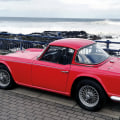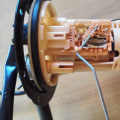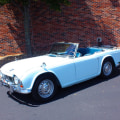When it comes to cars, one of the most important components is the steering system. Without it, drivers would have no way to control their vehicles. Knowing about the different types of steering systems, their specifications, and how they work can help you decide which one is right for you. From manual and power-assisted to rack-and-pinion and variable-ratio systems, there are a variety of steering systems available today. Each type has its own advantages and disadvantages.
Understanding the specs of each system can help you select the best option for your driving needs. This article will provide an overview of different steering system specs and types, as well as a detailed look at each type's features and benefits. We'll also discuss the importance of proper installation and maintenance for your steering system. The steering system is a crucial component of the Triumph TR, allowing drivers to control the direction and speed of the vehicle. This article covers the different types of steering systems, as well as their components and how they work. There are two main types of steering systems used in the Triumph TR: rack-and-pinion and recirculating-ball.
Rack-and-pinion steering systems use a pinion gear attached to the steering wheel and a linear rack. The pinion gear rotates as the steering wheel is turned, which in turn moves the rack in the desired direction. The movement of the rack is then connected to the wheels by linkages, allowing the driver to control the direction of the vehicle. Recirculating-ball steering systems also use a gear attached to the steering wheel, but instead of a linear rack, it is connected to a ball-and-nut assembly. Rack-and-pinion steering systems use a pinion gear attached to the steering wheel and a linear rack. The pinion gear rotates as the steering wheel is turned, which in turn moves the rack in the desired direction. The movement of the rack is then connected to the wheels by linkages, allowing the driver to control the direction of the vehicle. Recirculating-ball steering systems also use a gear attached to the steering wheel, but instead of a linear rack, it is connected to a ball-and-nut assembly.
As the steering wheel is turned, the gear turns the nut, which in turn moves a series of rollers and balls that drive the wheels in the desired direction. In both types of steering systems, there are several components that work together to provide control over the vehicle's direction and speed. The main components are the steering wheel, steering column, linkages, and associated hardware. The steering wheel is connected to a shaft that is attached to the steering column.
Turning the wheel causes the shaft to rotate, which in turn moves the linkages connected to it. The linkages then connect to either a rack-and-pinion or ball-and-nut assembly, depending on which type of system is being used. This in turn moves either the rack or the balls and rollers, which then move the wheels in the desired direction. In order for this movement to occur at an appropriate speed, there must be a mechanism that allows for some resistance when turning the steering wheel.
This resistance is provided by a series of springs located within the linkages. The combination of these components allows for precise control over the vehicle's direction and speed. For example, if a driver needs to make a quick turn or change speed quickly, they can do so by turning the steering wheel with a certain amount of force. The springs provide enough resistance that they do not have to worry about overcorrecting or moving too quickly.
To ensure that drivers have maximum control over their vehicles, it is important for them to understand how their steering system works and how each component functions. By understanding how these systems work, they can make sure they are using them correctly and safely.
Rack-and-Pinion Steering
Rack-and-pinion steering is a type of steering system commonly used in cars and other vehicles. It is composed of a circular gear, known as the pinion, and a linear gear, known as the rack.The pinion is connected to the steering wheel and is used to move the rack back and forth, allowing the driver to steer the vehicle. This type of system is simpler and more efficient than other types of steering systems, such as recirculating ball or worm-and-sector steering. The rack-and-pinion steering system is made up of several components, including the tie rod, the steering arm, the pitman arm, the idler arm, and the drag link. The tie rod connects the pitman arm to the steering arms, which move the wheels in response to the movement of the steering wheel. The pitman arm then transmits the motion of the tie rod to the idler arm, which then moves the drag link.
The drag link then moves the wheels in the direction desired by the driver. Compared to other types of steering systems, rack-and-pinion steering systems are much simpler and more efficient. They require fewer parts and are easier to maintain. Additionally, they are more responsive than other systems, allowing drivers to make sharp turns quickly and accurately.
Recirculating-Ball Steering
Recirculating-Ball Steering is a type of steering system that uses a recirculating ball to transfer the driver's steering input to the wheels. It is a simple, reliable, and cost-effective system that has been used for decades in cars and trucks.The recirculating-ball steering system consists of a steering wheel, connecting rods, pitman arm, idler arm, and a recirculating ball joint. The steering wheel is connected to the pitman arm via the connecting rods. The pitman arm then moves the idler arm which is connected to the recirculating ball joint. The ball joint is connected to the wheel, allowing it to turn in response to the driver’s input.
Recirculating-ball steering differs from other types of steering systems in that it does not require power steering fluid or hydraulic pressure to operate. It is also less complex and more reliable than other systems as it has fewer parts. Additionally, it does not require frequent maintenance and can last for many years with proper care. Overall, recirculating-ball steering is an effective way of controlling the direction and speed of the vehicle.
It is simple to maintain and provides reliable performance for many years. In conclusion, it is important to understand the different types of steering systems used in vehicles, and how they work together to provide control to drivers. The Triumph TR uses two common types of steering systems: rack-and-pinion and recirculating-ball. Each of these systems has its own unique components and design, but both provide drivers with control over the direction and speed of the vehicle.


